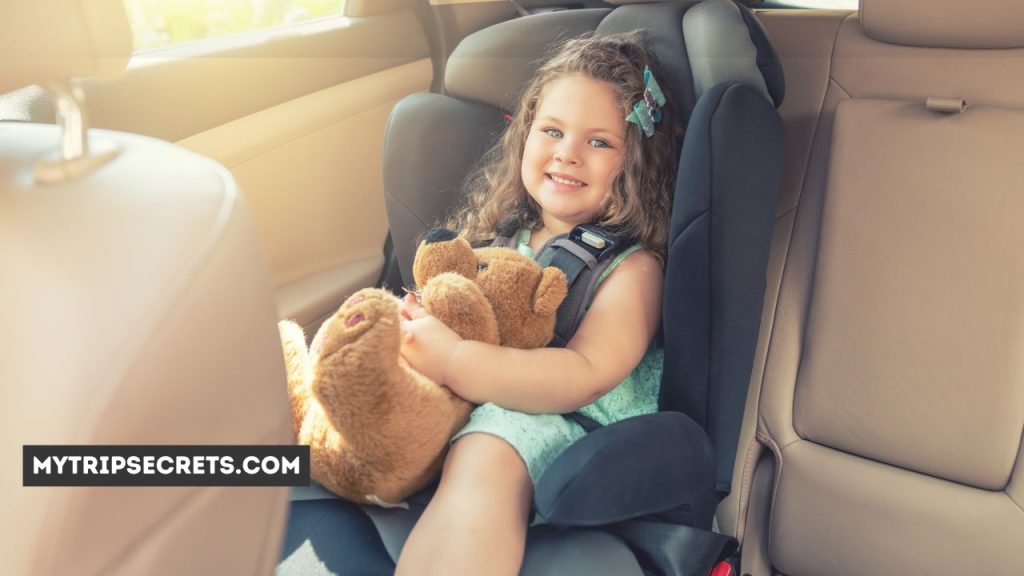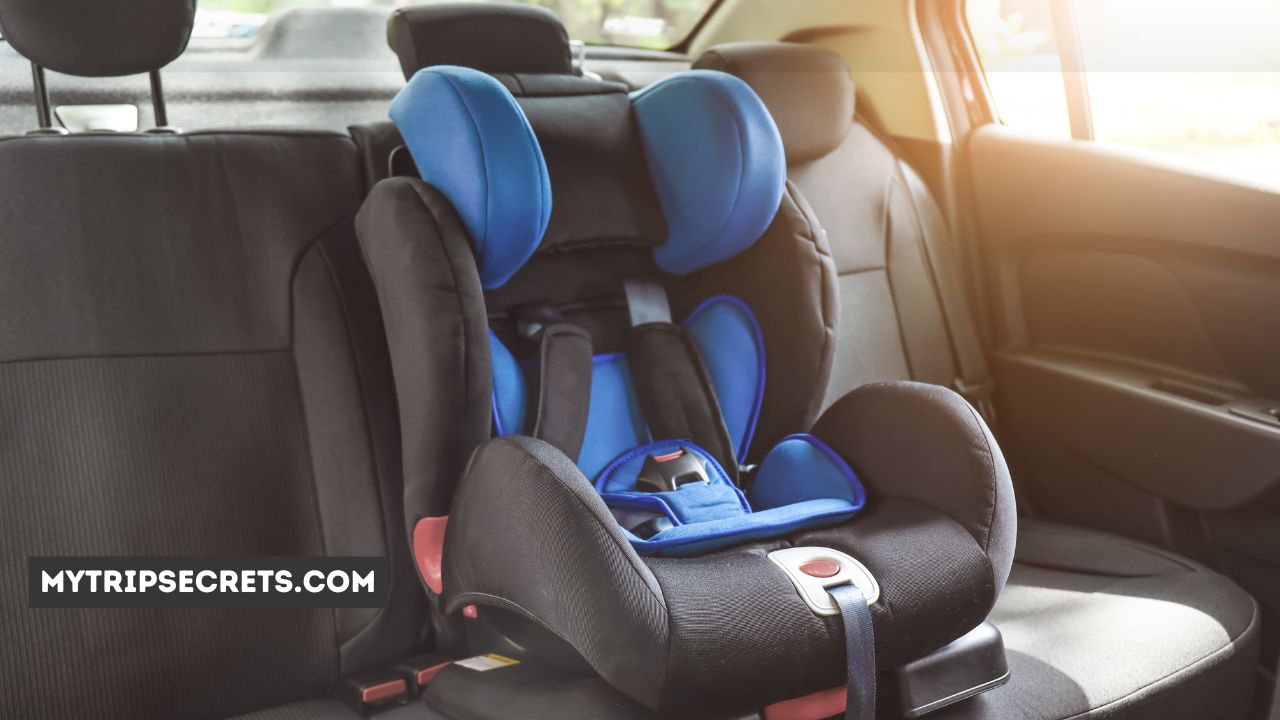When travelling with young children, it is unavoidable to bring along cumbersome equipment, particularly car seats when travelling. Despite the fact that the majority of car seats are designed to be as portable as feasible, the base of the seat is often retained within the vehicle. You will not have to deal with the hassle of buckling the detachable car seat straight into the vehicle each time you use this feature because it enables you to snap it in and out of the vehicle. Fortunately, there are a number of excellent choices available for transporting your car seat base, which will make travelling with children much simpler.
Contents
- 1 How to Travel with a Car Seat Base
- 2 Ways to Transport a Car Seat Base
- 3 Protecting the Base During Transport
- 4 Using Bases in Rental Cars
- 5 Tips for Installation
- 6 Flying with a Car Seat
- 7 Top Car Seat Bases for Travel
- 8 Frequently Asked Questions
- 8.1 Should I really squeeze a bulky base into my crammed luggage?
- 8.2 Can’t I just safely install the car seat without the base in rentals?
- 8.3 What’s the big deal if car seats are loose – can’t kids just wear seat belts instead?
- 8.4 Can I borrow a base from family or friends rather than packing my own?
- 8.5 My base got damaged flying despite my best packing efforts. Now what?
- 9 Conclusion
How to Travel with a Car Seat Base
Hauling around a heavy and awkward car seat base may seem like unnecessary extra baggage. But there are some key reasons why bringing it can make travel with kids much smoother:
Consistent Installation
Having the familiar base that you use regularly at home makes proper installation of the car seat quick, easy and reliable in the rental car or grandma’s vehicle. Fiddling with routing the seatbelt or latch system in an unfamiliar car is frustrating and can result in a loose fit. The base takes the guesswork out of getting a snug, safe fit.
Reduced Movement
Car seat bases lock the seat securely in place, limiting sideways tipping or front-to-back shifting. This extra stability protects your child in the event of sudden braking or crashes. Rental car seats may not fit as snugly or could work loose over time.
Child Comfort
In addition to enhanced safety, the stability from your own trusted base also keeps kids comfy. It prevents irritation from the seat moving around and makes it easier for little ones to sleep during car trips.
Convenience
Being able to quickly click the car seat in and out is extremely handy when traveling. You don’t have to disturb a napping baby to get them in and out for each stop. Some bases even allow you to adjust the recline angle while installed.
Ways to Transport a Car Seat Base
Taking your car seat base along for the journey will make installation and use much simpler. But how do you easily and safely transport the large, unwieldy base? Here are some handy methods to consider:
Checking on a Flight
Checking the base with your other luggage when flying is generally the most straightforward option. Be sure it’s well-protected in a padded, sturdy bag or box so it doesn’t get damaged. Call ahead to check policies – some airlines count it as a separate checked item for fees.
Gate Checking
Many airlines will gate check the base just before boarding if you request this. Gate checking may be less risky than putting it in the baggage hold since you can keep an eye on it all the way to the gate. Be aware there may still be fees. Prepare it in a well-padded, durable case.
Using a Luggage Strap
Security allowing, a luggage strap can let you wear the base on your back while navigating the airport. Often kids in strollers get priority boarding, so you can take advantage of that. Just be sure to well-cushion any hard edges with a towel or blanket to make it comfortable for wearing.
Shipping via Post or Courier
If you don’t want to hassle with transporting the base yourself, shipping it works too. Carefully pack it with ample padding and mark it fragile. Time the shipping so it arrives just before or on the day you arrive. Shipping fees vary widely so compare options.
Transporting in a Vehicle
For road trips in your own vehicle, the easiest solution is to just take the base out and take it with you. Protect the vehicle’s seat from damage using an old towel or blanket. You’ll have to securely stow the base when not installed – try moving middle seats out of the way and securing it with straps or cargo nets. (See the tips below on padding it for transport). Watch for overheating in hot climates.
Renting a Car Seat Base
Some car rental companies and even vacation property rentals offer car seat base rentals. Availability may be limited but this option means you don’t have to bring your own. Review policies closely for any age, size or other restrictions. Inspect upon arrival for recalls or excessive signs of wear. Don’t rely on just the base – bring the matching car seat too.
Protecting the Base During Transport
Whichever transport method you select, properly securing and padding the base will prevent damage in transit. Follow these tips:
- Pack in a durable, rigid container like a plastic storage bin or wheeled luggage case. This prevents crushing or cracking.
- Wrap all sides with 2-3 inches of high-density foam, bubble wrap or foam noodles to absorb impact.
- Use packaging tape to secure the padding firmly in place so it stays put.
- Affix “fragile” stickers and “this side up” arrows to instruct luggage handlers on careful placement.
- Attach your contact info inside and out in case of issues.
- Secure loose straps, buckles and adjusters with tape or ties so they don’t get tangled or catch.
- Investing in a padded car seat travel bag offers built-in protection and wheels for easy transport.
- If gate checking, have a oversized, durable duffel bag or cardboard box on hand at the airport.
Using Bases in Rental Cars
Rental cars promise convenience and affordability but installing your child’s car seat can be frustrating in an unfamiliar vehicle. Bringing your car seat base simplifies set up significantly. But there are still some things to consider when using your base in rental cars:
Spot Check Fit
Ideally do a quick fit check before fully loading up the car. Place the base in a couple seating positions to confirm it sits flush and the seat belts seem compatible. This avoids finding issues with fit after you’ve packed everything.
Review Manuals
Check both your base and car seat manuals as well as the rental car manual for installation tips. Your car seat may have special notes about using in certain vehicle types common in rental fleets.
Request LATCH Access
Many vehicles come with LATCH anchors but they may be recessed in cushions. Ask the rental counter to note LATCH access is required when choosing your car. If anchors seem hard to locate, switch to seat belt install.
Adjust Incline Settings
Your base may have recline adjustment settings allowing you to achieve the proper angle in differently contoured rear seats. Use a level to double check the angle is appropriate and make adjustments as needed.
Report Concerns
If you notice the base feels loose despite your best efforts or has any damage, immediately notify the rental company before leaving the lot. They should provide an alternate vehicle or base.
Tips for Installation
While bringing your car seat base makes attachment much easier in rental cars, you’ll still want to take care to get a solid installation. Follow these guidelines:
- Use your primary method: If your base normally uses the seatbelt, continue to use this rather than switching to lower anchors which may be unfamiliar. The same goes for primarily latch system users.
- Confirm connectors: Inspect where the seat belt or LATCH strap attaches through the base and car seat shell. Be sure nothing is damaged or particularly worn.
- Check for secure attachment: After routing through the belt path and buckling, try to shift the base side to side and front to back. If it moves more than an inch, it’s too loose.
- No gaps: The base should sit flush against the vehicle seat bottom and seat back with no gaps. Gaps mean it could shift in a crash. Add washcloths or pool noodles as needed to fill gaps.
- Use locking clips: If the vehicle seat belt lacks a locking retractor that holds tension, use the locking clip included with your car seat to secure the belt in place once tightened.
- Angle is crucial: Use the vehicle headrests as reference point. The base should recline the seat at about a 45 degree angle. Too upright or too reclined can be dangerous so double check with your level tool. Adjust base or vehicle seat inclines if needed.
Flying with a Car Seat
While less bulky than the base, flying with a car seat still poses logistical challenges. Here are smart tips to smooth the process:
- Book a window seat: This guarantees space to secure the car seat so it doesn’t obstruct the aisle. A window seat also prevents it from getting bumped and damaged as passengers load and unload.
- Notify the airline: When booking, let them know you’ll have a car seat so they block adjacent seats and prepare staff. Car seats may count as a carry-on item.
- Use a lightweight model: Opt for a compact, lightweight convertible seat under 10 lbs for easier lugging around airports and on the plane.
- Gate check or fly seat-only: Checking the base then using just the seat onboard can resolve space issues. Approaching flight attendants to “gate check” the base as you board also works.
- Bring backup padding: Carry a padded travel bag or garbage bag and light blanket in case space forces you to check the seat at the gate unexpectedly. Quickly surround it with padding before handing over.
- PRIORITY Tagged: Affix handles and shoulder straps so you can wear it comfortably through airports. Also attach colorful “Priority” tags pre-printed from home or your bag to identify kids are involved!
Top Car Seat Bases for Travel

While all car seat bases serve the same function of securely attaching car seats, some models offer extra convenience and portability for travel.
As the chart illustrates, several brands offer bases with features tailored specifically for travel and compatibility across a range of vehicles:
- Angle adjustment: Models like Evenflo, Chicco and Graco bases allow parents to tweak the recline angle. This helps achieve proper positioning in differently contoured vehicles.
- Premium padding: Thicker, plusher padding on certain bases helps prevent vehicle upholstery damage during transport when removed. Britax and Cybex are notable for lush cushioning.
- Hassle-free installation: User-friendly belt lock-offs built into the Cosco and Doona bases take the frustration out of routing seatbelts and achieving a tight, secure fit.
- Compact size: Slim dimensions on choices like Nuna and Clek matter when you’ll be packing it in baggage. Every inch counts for airplane luggage allowances!
- Lightweight: Models from Baby Jogger, Maxi Cosi and uppababy keep overall weight low for easier lifting and carrying.
- LATCH compatibility: Even in rental cars with poorly located lower anchor points, adaptable LATCH connectors on bases from Chicco and Doona simplify connections.
Key Considerations
When selecting a car seat base to purchase specifically for travel, be sure to:
- Match the base brand/model to your car seat. They are not interchangeable across brands.
- Check size and weight to confirm they meet your travel needs. Think planes, trains and automobiles!
- Read reviews and ratings to choose units proven reliable after transport and trips. Durability matters.
- Look for availability of replacement parts. Even with careful packing things happen.
Frequently Asked Questions
Should I really squeeze a bulky base into my crammed luggage?
Yes! While lugging it around seems annoying up front, you’ll be glad you brought it when installation takes 2 minutes without frustration versus fumbling with an unfamiliar car seat in a rental for 30 minutes or more…while the whole family impatiently waits!
Can’t I just safely install the car seat without the base in rentals?
You can safely install without the base IF you take the time to carefully review the car seat and vehicle manuals each time, confirm it feels rock solid in every budge and pull test, and double check angles with a level tool. But who wants that hassle and uncertainty every time the seat is moved across multiple rentals and vehicles? The base saves tons of trouble.
What’s the big deal if car seats are loose – can’t kids just wear seat belts instead?
You should NEVER allow a child under age 13 to just use vehicle seat belts. Young bodies and bone structure require the extra protection boost only car seats provide. While it may seem like a loose fit wouldn’t matter much, studies show even small amounts of movement multiply crash forces. Snug installations keep little passengers safe. Don’t cut corners!
Can I borrow a base from family or friends rather than packing my own?
This works only if the bases are identical models – they are not interchangeable even across the same brand. Checking serial numbers must match the car seat you’ll use. Used bases should also have no signs of wear, damage or manufacturer recalls. If in doubt, pack your tried and true base you use daily for confidence.
My base got damaged flying despite my best packing efforts. Now what?
First off, congratulate yourself for properly cushioning it in anticipation of worst case scenarios. No one wants to deal with damage but you wisely minimized it. Notify the airline and file claims right away. Then contact the car seat manufacturer – many allow you to order individual replacement parts for bases even long after purchase. They understand components weaken after rough baggage handling – no judgement! In future you may want to explore shipping bases ahead or buying an inexpensive backup expressly for travel contingencies.
Conclusion
Bringing tiny children on a plane or in a car already requires enough gear to make the Sherpas sick, as any parent or guardian knows. You may be afraid of the cumbersome car seat base, but trust me when I say it’s worth it. Carrying the hardware is a minor cost when it comes to protecting your most valuable cargo. When you bring your trusted base with you on a trip, you’ll be able to install car seats in strange rental automobiles with ease and safety. With your children safely fastened, you may enjoy your adventures without worry. It doesn’t matter where you’re going on a family road trip—as long as you plan ahead to keep the base safe, make good use of luggage allowances, personalise cushioning, and check fit.

